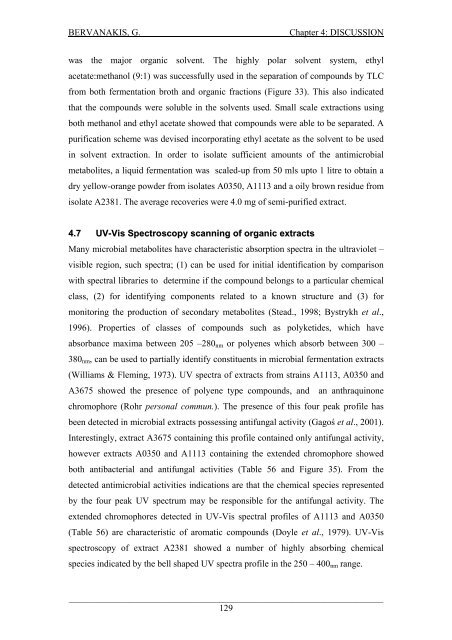Detection and Expression of Biosynthetic Genes in Actinobacteria ...
Detection and Expression of Biosynthetic Genes in Actinobacteria ...
Detection and Expression of Biosynthetic Genes in Actinobacteria ...
Create successful ePaper yourself
Turn your PDF publications into a flip-book with our unique Google optimized e-Paper software.
BERVANAKIS, G.Chapter 4: DISCUSSIONwas the major organic solvent. The highly polar solvent system, ethylacetate:methanol (9:1) was successfully used <strong>in</strong> the separation <strong>of</strong> compounds by TLCfrom both fermentation broth <strong>and</strong> organic fractions (Figure 33). This also <strong>in</strong>dicatedthat the compounds were soluble <strong>in</strong> the solvents used. Small scale extractions us<strong>in</strong>gboth methanol <strong>and</strong> ethyl acetate showed that compounds were able to be separated. Apurification scheme was devised <strong>in</strong>corporat<strong>in</strong>g ethyl acetate as the solvent to be used<strong>in</strong> solvent extraction. In order to isolate sufficient amounts <strong>of</strong> the antimicrobialmetabolites, a liquid fermentation was scaled-up from 50 mls upto 1 litre to obta<strong>in</strong> adry yellow-orange powder from isolates A0350, A1113 <strong>and</strong> a oily brown residue fromisolate A2381. The average recoveries were 4.0 mg <strong>of</strong> semi-purified extract.4.7 UV-Vis Spectroscopy scann<strong>in</strong>g <strong>of</strong> organic extractsMany microbial metabolites have characteristic absorption spectra <strong>in</strong> the ultraviolet –visible region, such spectra; (1) can be used for <strong>in</strong>itial identification by comparisonwith spectral libraries to determ<strong>in</strong>e if the compound belongs to a particular chemicalclass, (2) for identify<strong>in</strong>g components related to a known structure <strong>and</strong> (3) formonitor<strong>in</strong>g the production <strong>of</strong> secondary metabolites (Stead., 1998; Bystrykh et al.,1996). Properties <strong>of</strong> classes <strong>of</strong> compounds such as polyketides, which haveabsorbance maxima between 205 –280 nm or polyenes which absorb between 300 –380 nm , can be used to partially identify constituents <strong>in</strong> microbial fermentation extracts(Williams & Flem<strong>in</strong>g, 1973). UV spectra <strong>of</strong> extracts from stra<strong>in</strong>s A1113, A0350 <strong>and</strong>A3675 showed the presence <strong>of</strong> polyene type compounds, <strong>and</strong> an anthraqu<strong>in</strong>onechromophore (Rohr personal commun.). The presence <strong>of</strong> this four peak pr<strong>of</strong>ile hasbeen detected <strong>in</strong> microbial extracts possess<strong>in</strong>g antifungal activity (Gagoś et al., 2001).Interest<strong>in</strong>gly, extract A3675 conta<strong>in</strong><strong>in</strong>g this pr<strong>of</strong>ile conta<strong>in</strong>ed only antifungal activity,however extracts A0350 <strong>and</strong> A1113 conta<strong>in</strong><strong>in</strong>g the extended chromophore showedboth antibacterial <strong>and</strong> antifungal activities (Table 56 <strong>and</strong> Figure 35). From thedetected antimicrobial activities <strong>in</strong>dications are that the chemical species representedby the four peak UV spectrum may be responsible for the antifungal activity. Theextended chromophores detected <strong>in</strong> UV-Vis spectral pr<strong>of</strong>iles <strong>of</strong> A1113 <strong>and</strong> A0350(Table 56) are characteristic <strong>of</strong> aromatic compounds (Doyle et al., 1979). UV-Visspectroscopy <strong>of</strong> extract A2381 showed a number <strong>of</strong> highly absorb<strong>in</strong>g chemicalspecies <strong>in</strong>dicated by the bell shaped UV spectra pr<strong>of</strong>ile <strong>in</strong> the 250 – 400 nm range._____________________________________________________________________129















